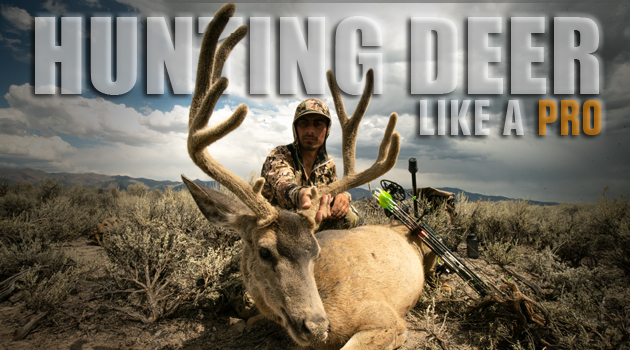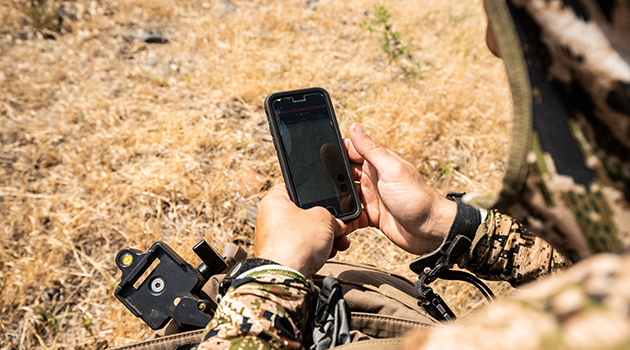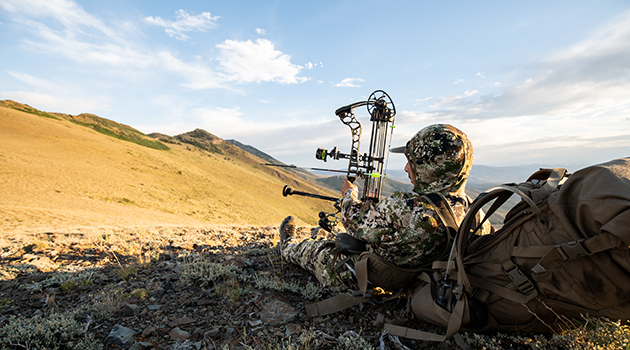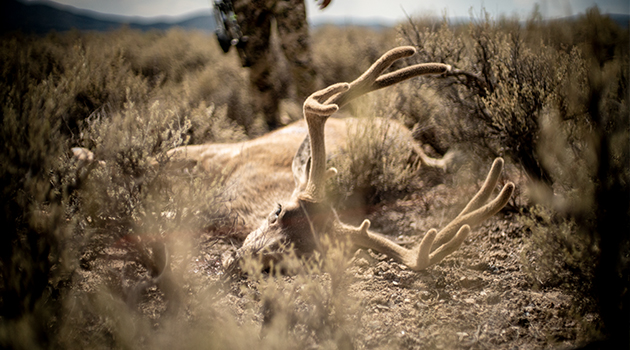Hunting and Fishing News & Blog Articles
Hunting Mule Deer Like a Pro
Big mule deer are some of the toughest, most prized trophies out West. They live from the desert to the mountain peaks and everywhere in between. They are wily and have great instincts to stay one step ahead of hunters. Big mature bucks learn how to survive and have a knack for making the right moves at the right times. Depending on the time of year you hunt, the bucks will be found in different locations and have different habits. Each season will take a different set of tactics to consistently harvest good bucks.
I have hunted every different season and nearly every western state for big muley bucks. I have hunted sage draws to the gnarliest mountain peaks and have a knack for finding big mature bucks. I have had a handful of tough to draw limited units and have had a boatload of easy general tags. Truth is that big mule deer do not just live in the toughest to draw units they live all throughout the West. I have harvested multiple giants in easy to draw units. It’s more about your skill and knowledge as a muley hunter than some special tag. Big, mind-blowing trophies are out there, it’s just about learning how to hunt mule deer like a pro.
Early Season
Locating a giant buck is going to be your biggest challenge. You have to learn and dissect the unit you will be hunting to consistently locate mature bucks. Now each different season you hunt the bucks will have different behaviors and have bucks hanging in different locations. I consider the early season to be August 15 through September 15. You guys that have read my writing know I love this season for high country mule deer.
I know a lot of these seasons are with a bow but there is opportunity for rifle hunters to get in on the action too. There are opportunities in Idaho, Colorado, Wyoming and even early backcountry hunts in Montana. This is a great opportunity to find and harvest big mature bucks. The bucks this time of year will be hanging in bachelor groups and focused on food sources. They will be at the tops of the mountain hanging in open alpine basins. It’s all about covering miles and glassing this time of year. When you find a buck, chances are there will be more around, so keep glassing. The bucks just seem to be off guard this time of year and show themselves more. The country they live in is rough and rugged but conducive to glassing.
Mid-Season
The next chance you will get to hunt mulies will be mid-season. I consider this to be September 15 through November 1st. This will be your toughest time trying to find a big buck but not impossible. Bucks shed their velvet and start running solo. If you are hunting the mountains, the bucks will drop off the top into the next level of country. That’s where it gets tough because the level below the alpine peaks offers a lot of cover for mature bucks.
They drop down into gnarly, cliffy, tough-to-access country. They will feed in little sliver openings or avalanche chutes and then quickly disappear into cover. Bucks tighten up their program here and usually only show themselves at first and last light. They will get up throughout the day but usually under the cover of timber. The key during this season is to get down off the top of the mountain 1,000 feet or so and find vantage points that expose these little isolated openings. They can be tough to find and tough to kill but it can be done. You are not going to see a ton of bucks so you have to keep the faith and keep glassing to turn them up.
Late-Season
The final season is the late season. I consider this season to be November 1st through January. These are awesome hunt dates and if you are lucky enough to draw one of these tags, you are in luck. Big muley bucks will be rutting this time of year and they drop their guard. They travel tons of miles and can be found in the sage brush winter range or on the faces of the big mountain peaks. Find the does this time of year and you will find the bucks.
Now just because you drew one of these tags does not mean you are on easy street, you still need to hunt hard. You cannot just plan to drive around and hope you bump into a monster. Bucks that live to be five years old or older don’t get that big by rutting does of the side of the road. They are rut crazy, but to live that long they rut does in isolated drainages off the beaten path. Usually the smaller immature bucks will chase and bread those does around high pressure. Big bucks know better.
Locating Bucks
Every season in mule deer country means different behaviors and different areas. Once you get yourself a plan for the season you will be hunting, time to put boots to ground. Mule deer love big isolated basins and will use the bottom of drainages to travel country. I start by finding some easy to access spots to check out. I will look for an easy walk up a hill or around a corner. Look for vantage points or ridgelines that unlock country that you can’t see off a dirt road. Seems even in tough to draw limited tags the big bucks are not where they can be easily spotted. They learn and move to unpressured country. So I start here and will have a handful of these easy-to-get-to spots where big ones can be lurking.
I will also have spots that take more effort to get into. This does not mean you have to hike 20 miles into a spot, usually even three miles will get you into fresh, untouched muley country. I look for the same thing here as I do in my easy spots. I look for drainages or basins that cannot be easily seen by other hunters. I look for vantage points or ridgelines that show off large tracks of land. I always make sure I am in the best spots at the best times – that is key! You can look at the best muley country full of mule deer but if you look at 10 a.m. you usually will not see a buck. You have to be at these spots and vantage points at first and last light or you will not see what really lives there. Only after I look at a spot at the right time can I determine if there are deer there or not.
Field Judging Mule Deer
Once you start finding deer, your field judging skills will come into play. It is really easy to make a decent buck look bigger than he really is. Now what size and type of deer you are after is up to each hunter but you want to make sure the deer meets you expectations. I always have my spotting scope when hunting mule deer, it’s the only way I can accurately field judge.
First thing I look at is how deep are the forks. This will be the biggest tell when looking at mule deer. I use the ear as a measuring tool and figure the ear is on average 8” long. If the buck has 12“ deep forks, front and back, he’ll go 190 to 200. If he has 8” front and back, he’ll go in the 170 to 180 range. If he’s 6” front and back, I figure about 150 to 160.
Now these are just rough figures but the forks will tell you a lot about a buck. I then look at the spread. Now spread does not say everything about a buck but will give you an idea about how big. A deer’s ear-to-ear spread can differ depending on the deer body size and their state of residence. I have seen the spread vary anywhere from 20 – 26”. I like to figure 24“ to be safe. Also, deer that go wide in their fronts usually have a good main beam measurements. Mass seems to make the deer but sometimes can be tough to tell. If the buck has width, height, or good forks he will usually be old enough for good mass too.
I have also used a modified system I first read about from Mike Eastman. It is to add up all the inches on a buck to know what he scores. Now this system takes some practice and also takes measuring a lot of deer. So the more you use it and the more you prove your system, the better you will get. I take one side of the rack and add it up, double it and then give him a spread.
I start with the main beams and try to use the ears as a measuring tool. I also use knowledge of main beam lengths when I do this. I know that a really good 32” wide buck will have 24 – 28” beams. A narrow, good buck will be 20 – 24”. I then add the G2 by using the ears. I think 16 – 20” is a good, tall buck. Then I add in the G3 and G4 which makes up how deep the forks are. Next I add in the eye guards. Standard eye guards are 3”, so estimate those and add them in.
Then for mass, bucks usually end up 15 – 20” per side. Then last give him a spread. Now remember for score, your spread is in between the main beams. A 32” buck will usually only get a 27” inside after the main beams are factored. So, 20 – 24” is way more common for inside spread. This is how your equation should look when you get done…
Main beams: 27
G2: 20
G3: 10
G4: 12
G1 (eye guard): 3
Mass 20
Subtotal: 92
Doubled: 184
Spread: 26
Total score: 200 inches
Sealing the Deal
The final piece to the puzzle is closing the deal – easier said than done for sure. I see a lot of guys that get lost in the fog of adrenalin here. Be cool, be calm and don’t rush. Guys see a big buck and then will run or hurry to get set up letting the buck pick up their movement. Bucks are way easier to hit when they have no idea you are there. Once you see the buck you want be patient and make a good plan to close the distance. Most of the time you will not be able to get to a buck before he puts away for the day. Now you can chase after him in the timber but that is low percentage. Your best bet is to plan where he will come out in the evening or the next morning and then put yourself in a good shooting position.
Shot distance is different for each hunter but make sure it is inside your effective range. Some guys spend tons of time with their rifles and can make incredible shots at extreme distances; you know who you are. Those long shots can be made but there are a lot of variables. I like to get in close and kill them. For me if I can get inside 300 I know it is a dead deer, 200 better yet. No matter what your maximum range, everyone should be practicing with their rifle and practicing their different shooting positions. Know your rifle inside and out and be ready for your opportunity.
Making a shot on a big muley buck is not a given and I can’t tell you how many chip shots I have seen missed. Being a good rifle shot is all about the rest. Prone is best but is not always possible. If you are shooting from a sitting position make sure to get a good rest and put a pack underneath your back elbow. You need to be able to float those crosshairs over the vitals and just squeeze. Biggest mistake I see is the crosshairs hit hair and the shooter jerks back on trigger. I have been guilty of this myself and there is no telling where that shot will go. So know your ballistics and practice with your weapon because it will all come down to you making that shot.
I have always loved hunting mule deer because a big one has to be earned. They are very rarely shot out of treestand or blind and they can’t be artificially grown. Mule deer live wild and free on our public lands across the west. Super tags can be tough to come by but if you’re crafty, you can hunt mule deer in multiple states every year. There is great opportunity to harvest world class deer you just have to work at it. The more places and more time you spend hunting mule deer the better you get. Take these tips to heart as I have ran myself through the trials and tribulations mule deer country has to offer. Hunt hard, hunt smart and the sky is the limit.
The post Hunting Mule Deer Like a Pro appeared first on Eastmans' Official Blog | Mule Deer, Antelope, Elk Hunting and Bowhunting Magazine | Eastmans' Hunting Journals.
Copyright
© Eastmans





